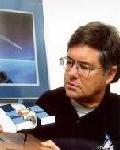 |
|
 |
|
Tom
Duxbury
Project Manager
|
|
Don
Brownlee
Project Principal Investigator
|
|
Missions with objectives of
returning cometary samples had been proposed previously
but the mission concepts had not been approved. The
1994 Discovery Announcement of Opportunity (AO) opened
the door for missions that could be launched at a development
phase cost of less than $150 million in 1992 dollars
(when Discovery program was authorized by Congress).
The focused mission concept for Stardust was the brainchild
of Dr. Peter Tsou. Dr. Donald Brownlee of the University
of Washington, who would be Principal Investigator and
collaborated with Dr. Peter Tsou for the last two decades
in returning samples from cosmic dust and comets. Dr.
Benton Clark of Lockheed Martin led the definition of
a simple spacecraft and sample return capsule to accomplish
the mission.
The implementation plan was tailored to the schedule
dictated by finding a trajectory that would allow the
Comet P/Wild 2 to fly by Stardust at a relatively slow
6 km/sec. This would enable the capture of comet dust
within aerogel. Successful particle capture up to 10
km/sec has been demonstrated at JPL. Capturing particles
intact at this hypervelocity (about 6 times the speed
of a rifle bullet) is a pretty incredible feat!
In the fall of 1994 the first competition for Discovery
missions resulted in the selection of the Lunar Prospector
and three missions to compete in a Phase A definition
study. In late 1995 the Stardust mission was selected
to be the fourth Discovery mission.
On February 7, 1999 the Stardust spacecraft was successfully
launched aboard a Delta 2 rocket from Cape Canaveral
Air Station, Florida and thus started Stardust's journey
to be the first NASA mission to return particles from
beyond the Earth Moon orbit.
We hope you have fun experiencing this web site. To
gain the most from this site, you can step easily through
the main topics by clicking on each topic listed from
left to right in the navigational buttons at the bottom
of each page. Or you can click directly on the navigational
buttons and go to the subject of your choice.
Tell
us what you think of our web site, and what you
would like to learn more about of the STARDUST Project.
| Last updated December
8, 2003 |
|
